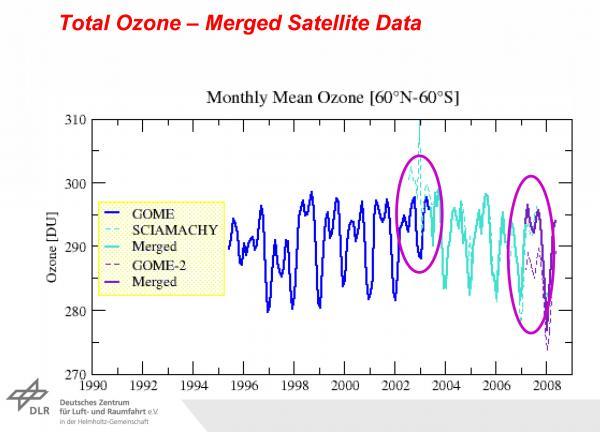By consolidating the observations of European satellites over the past decade, scientists have obtained long-term and consistent data on ozone levels, allowing them to capture trends. global transformation of ozone layer.
Scientists have gathered monthly data on ozone levels as measured by GOME devices on the ERS-2 satellite of the European Space Research Agency (ESA), SCIAMACHY on Envisat and ESA and GOME-2 on MetOp-A of the European meteorological organization.
Project member Diego G. Loyola R. said: 'We have found a positive trend that has increased ozone by an average of 1% every decade after surveying the past 14 years: this result matches the measurements carried out on the ground. '
Ozone is the upper layer of protection mainly in the stratosphere, 25 km above the ground, acting as a sun filter that prevents most harmful ultraviolet rays from penetrating the Earth's atmosphere.The thinner the ozone layer is, the more people face the risk of skin cancer, and the more threatened the marine life on Earth.
The amount of ozone is not evenly distributed, most changes occur in the upper stratosphere. With the collection of data from horizontal observation rather than vertical top-down, the above tools are capable of providing more accurate numbers on the stratosphere.
A group of scientists led by Ashley Jones and Jo Urban from Chalmers University of Technology, Switzerland combined the horizontal observation results obtained from US SBUV, SAGE I + II and HALOE devices with data from OSIRIS, SMR and SCIAMACHY on European satellites Odin and Envisat to analyze the long-term development of ozone in the stratosphere in 1979-2008.These data show a reduction in ozone levels from 1979 to 1997, and slightly increased since 1997.
 The average monthly ozone content in the geographic region is 60 ° North to 60 ° South according to GOME, SCIAMACHY and GOME-2 data sets. (Photo: Diego Loyola, DLR)
The average monthly ozone content in the geographic region is 60 ° North to 60 ° South according to GOME, SCIAMACHY and GOME-2 data sets. (Photo: Diego Loyola, DLR)
'Our analysis shows that in the period 1979-1997, the ozone level in the stratosphere decreased by nearly 7% per decade at average latitudes. This is a result consistent with previous studies based on data obtained from satellites as well as measurements of ground tools. Since 1997, a new trend has begun to appear. From here, it recorded a low increase (0.8–1.4% per decade), but this is a modest number, almost equal to 0. We are waiting to see a strong recovery. more of ozone in the coming years, ' Urban said.
The decline in ozone is caused by human-made chemicals such as chlorine and human bromine that last for a long time in the atmosphere. The Montreal Protocol was signed in 1987 with the aim of limiting and ultimately ending the use and production of these substances.The effectiveness of the protocol was clearly seen through satellite observations of ozone levels and concentrations of these gases.
Using SCIAMACHY's horizontal observational data from 2002 to 2008, François Hendrick from Belgium's Aerospace and Aerospace Research Institute (BIRA / IASB) and colleagues conducted a trend analysis. bromine monoxide (BrO) in the stratosphere. BrO is a very strong catalyst for ozone destruction. The results show that the concentration of BrO in the stratosphere has gradually decreased over the aforementioned time.
'The consistency between the above results and ground observations suggests that SCIAMACHY data can be used to capture the development trend of BrO levels in the stratosphere. This is strong evidence that the Montreal Protocol stipulates the restriction of bromine-based substances now working on the stratosphere, ' Hendrick said.
Accessing atmospheric data from satellites over time is important, helping scientists identify and analyze changes and trends in ozone production. In addition to capturing ozone trends, scientists will continue to monitor ozone-depleting substances that are restricted in the Montreal Protocol but still exist in the atmosphere.
Detailed results are presented in ESA's atmospheric scientific workshop held in Barcelona, Spain on 7-11 September. The goal of this workshop is to provide scientists with the opportunity to present the latest research results and application projects including the use of aerospace equipment such as atmospheric monitoring tools.
 'Fine laughs' - Scary and painful torture in ancient times
'Fine laughs' - Scary and painful torture in ancient times The sequence of numbers 142857 of the Egyptian pyramids is known as the strangest number in the world - Why?
The sequence of numbers 142857 of the Egyptian pyramids is known as the strangest number in the world - Why? History of the iron
History of the iron What is alum?
What is alum?